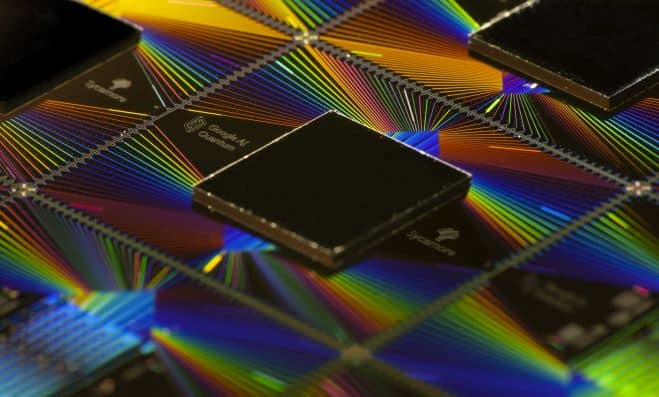
Crystalline solids such as diamond have a hallmark property: their structure is periodic in space. For much of the past decade, physicists have wondered whether a similarly robust, repeating structure might also exist in time. By analogy with spatial crystals, this structure is known as a time crystal, and whereas diamonds may be forever, time crystals are both forever and forever changing.
Researchers have proposed several physical systems that could host time crystals, including platforms like nitrogen-vacancy (NV) centres and trapped ions. Most recently, a collaboration between researchers at QuTech, TU Delft and UC Berkeley demonstrated long-lived period-doubling oscillations in carbon-13 NV centres across a variety of initial conditions. However, each of these previous platforms lacked the full slate of capabilities to necessary to realize (and verify) a genuine time crystal.
Now, researchers at Google Quantum AI and Stanford University in the US have constructed a time crystal on Google’s Sycamore quantum processor, demonstrating that these exotic objects constitute their own distinct phase of matter. To do so, they ran a series of “experiments” on Sycamore, treating the computer as a laboratory to test whether their proposed time crystal met certain requirements. The result is the first to experimentally verify that a phase of matter can exist outside of thermal equilibrium. It also shows that even in today’s world of noisy intermediate scale quantum (NISQ) computing, quantum processors already have important implications for our understanding of physics.
Phases of matter
Phases of matter come in many varieties, from ubiquitous liquids and gases to quantum phases like superconductors and Bose–Einstein condensates that only crop up under extreme conditions. Regardless of their properties, all phases share a key quality: each one has some notion of order, a way of quantifying the patterning of particles within the collection.
Crystalline solids, for example, exhibit spatial ordering. When a crystal forms, a discrete set of points from the continuous expanse of space become the loci for its evenly spaced atoms. In so doing, the system breaks a well-known physical symmetry: as far as the fundamental laws of physics are concerned, no point in space should have priority over any other. This cosmic apathy is reflected in a set of symmetries, or transformations, under which these laws must remain invariant.
One such symmetry, known as continuous translation symmetry, implies that shifting a closed physical system by any amount in any spatial direction is inconsequential. During formation, crystals spontaneously break this continuous symmetry; in other words, they break it even though the system is not explicitly swayed towards any particular choice of points. The repeating pattern that remains displays only discrete translation symmetry: if every atom is shifted over by one interval, or unit cell, of the crystal, then the same set of spatial positions (apart from the edges) will retain their distinction.
Time crystals enter the fray
The fundamental forces of nature also regard all points in time with indifference. In other words, the laws of physics stay the same from second to second and day to day. This invariance is referred to as continuous time-translation symmetry. Just as crystalline solids disrupt the continuous translation symmetry of space, systems such as pendulums swinging to and fro and planets orbiting stars carve the infinite extent of time into regular, discrete intervals.
Unlike space, however, the passage of time is indelibly coloured by the second law of thermodynamics, which states that entropy – the amount of randomness or disorder in a closed system – cannot decrease over time. Simple systems, like a single pendulum or a planetary orbit, can exhibit stable, long-lived oscillations, as there are few ways for their constituent pieces to interact with each other and exchange energy. In contrast, oscillations quickly fall out of sync in systems with many degrees of freedom (such as a collection of coupled pendulums), as energy surges through every allowed avenue and the system explores many possible states.
In 2012 the physics Nobel laureate Frank Wilczek proposed that an extended phase of matter could exhibit regularity and ordering in time, while also spontaneously breaking time-translation symmetry. Drawing an analogy with the spatially ordered crystalline solid, Wilczek called this proposed phase a quantum time crystal. At that point, it was unclear whether such a phase could truly exist in the physical world, or whether entropy would extinguish all hope for time-crystalline order.
Wilczek’s original proposal involved the ground state, or lowest energy configuration, of a superconducting ring. By itself, this superconductor supports a steady current that flows without resistance. If an alternating pattern of electric charge known as a charge density wave is then superimposed onto this constant current, the ripples of charge would break down the continuous translation symmetry of space into a discrete translation symmetry. Combining the two, Wilczek hypothesized, would result in a stable many-body system with reduced (from continuous to discrete) time-translation symmetry.
Need for non-equilibrium phases
In 2014 theoretical physicists Haruki Watanabe and Masaki Oshikawa dealt a striking blow to Wilczek’s proposal, and to the prospect of time crystals. Their “no-go” theorem stated that any system in thermal equilibrium, including Wilzcek’s, could not be a time crystal. Instead, any time-crystalline phase would need to enter a strange new realm: non-equilibrium physics.

Around the same time, physicists at Princeton University, US and the Max Planck Institute in Dresden, Germany were working in earnest to define such phases. For years, other physicists had pursued similar research programs with little to show for it, but Vedika Khemani (now a professor at Stanford), Roderich Moessner, Shivaji Sondhi and colleagues succeeded, theoretically demonstrating a stable non-equilibrium phase. Their recipe contained two essential physical ingredients: periodic or Floquet driving, and many-body localization (MBL).
When a system is out of equilibrium, its dynamics must depend nontrivially on time, with the state of the system constantly evolving. Floquet driving evokes such dynamics by making the system interact with a laser (or microwave) pulse. The strength of coupling between the system and the laser is varied periodically, and this periodicity modifies the system’s temporal symmetry. While the fundamental forces don’t depend on time, the dynamical pressures generated by the coupled laser are cyclic. From the system’s point of view, time’s translational symmetry is now discrete rather than continuous, and its governing physics looks the same only at times separated by exact multiples of the Floquet driving period.
Reduction in symmetry alone, however, does not a time crystal make. Whereas the continuous translation symmetry breaking in a crystalline solid is spontaneous, symmetry breaking via Floquet driving is induced by coupling the system to the laser. Any time crystal constructed from a Floquet-driven system must therefore spontaneously break the discrete translation symmetry it inherits from the driving mechanism.
In Floquet-driven systems, this is typically done via a phenomenon known as period doubling, where the system falls into a regular cycle that takes twice as long as the period of the process that governs it. The phenomenon dates back to 1837, when Michael Faraday experimented with thin layers of liquid on top of oscillating piston-like platforms, and observed that the standing waves that formed in the liquid moved at half of the oscillator’s frequency. Period doubling does not guarantee a time crystal either. What it does do, when combined with a Floquet-driven many-body system, is to make time crystalline order possible – with one big caveat.
In most Floquet systems, the driving laser imparts energy to the system with every cycle. As the system absorbs this energy, both its temperature and entropy increase. Eventually entropic randomness overwhelms any information contained in spatial or temporal correlations, and the system no longer exhibits any order, crystalline or otherwise.
Many-body localization to the rescue
There is, however, one special class of physical system that overcomes this problem by skirting the encroach of entropy: systems exhibiting many-body localization (MBL). The term “localization” refers broadly to a set of phenomena in which particles or physical properties are confined in their motion. This confinement often stems from disorder. For example, in Anderson localization, named after the late physics Nobel laureate Phil Anderson, disorder in a crystal lattice immobilizes the electrons that would otherwise be free to travel from one atom in the lattice to another.
Whereas an ideal crystal comprises uniform atomic nuclei, leading to a regular lattice structure, in practice crystals can be dotted with defects – that is, with nuclei of different elements randomly interspersed in the lattice. These defects push and pull electrons in different directions, creating complex potential energy landscapes with deep, narrow trenches that act as traps.

MBL, which Anderson also proposed, is a special type of disorder-induced localization that occurs in interacting quantum systems. When a many-body system is subjected to small quantities of randomness, these disturbances can spoil global symmetries like spatial translation invariance. However, once the degree of disorder exceeds a certain threshold, a set of new, local symmetries emerges, freezing particles in place.
Mired in strong many-body disorder, the particles in an MBL system have no way of absorbing energy. Correlations between particles are fixed from the start, and entropy stays the same, just barely satisfying the second law of thermodynamics. Crucially, the system never achieves thermal equilibrium.
Disorder begets order
In 2015 Khemani and colleagues showed that Floquet driving and MBL together make time crystals a distinct possibility, owing to the spontaneous symmetry breaking of the former and the entropy evasion of the latter. There is, however, one further ingredient. The key to combining Floquet driving and MBL to create a non-equilibrium phase of matter is a property of MBL known as eigenstate order.
In conventional phases of matter, physical quantities are measured and averaged over a thermal ensemble – a collection of states that captures the behaviour of the system at a fixed temperature. Individual states within that collection, known as eigenstates, are for the most part inaccessible and irrelevant. In MBL systems, on the other hand, where thermal equilibrium is never reached, these individual states are essential. For different initial conditions, the localizing randomness drives the system into different eigenstates.
Eigenstate order is also unique in that every eigenstate has a companion eigenstate. When time translation symmetry is broken, it is hard to define a consistent notion of energy. Instead, it makes sense to talk about the closely related concept of a quasi-energy, which is periodically defined, and behaves like a phase. Energies or quasi-energies can in theory be paired up in non-MBL systems; in practice, however, this partnership is sensitive to the slightest imperfections. In MBL systems, energies align not in spite of randomness but because of it. Even under imperfect conditions, this equality is exact – a rigidity that makes MBL well-suited for constructing time crystals.
Putting the pieces together
In their quest to define a non-equilibrium phase of matter, Khemani and her collaborators constructed a theoretical model that integrated Floquet driving and MBL. In this model, they envisioned a 1D chain of particles, each with its own quantum mechanical spin. Every particle in the chain is coupled to its neighbours and is also subject to its own local magnetic field.

At equilibrium, even when all the magnetic fields and coupling strengths are uniform, this system can only exhibit magnetic phases. A ferromagnet, for instance, has all spins pointing either up or down, whereas in a paramagnet, each spin individually points up or down but the system shows no overall preference. When disorder is incorporated into the field strengths and couplings, the system hosts an additional, many-body localized phase, where the spins point in random directions. This phase, known as a spin glass, derives its name by analogy with glass, which is an amorphous solid composed of randomly located atoms.
Out of equilibrium, the model hosts a further two phases, one of which is time crystalline. In the scenario Khemani considered, the system is periodically driven with a laser that modulates the strength of the coupling between neighbouring spins, alternating below and above the disorder strength that induces many-body localization.
For a given initial configuration of the spins, the disorder first forces the system into a spin-glass eigenstate. Oscillating between weak and strong interactions, over the course of a single cycle the Floquet drive rotates all the spins 180 degrees into the companion eigenstate with paired quasi-energy. Another cycle rotates the spins by an additional 180 degrees, bringing the system back to the first eigenstate. Under the influence of the Floquet drive, the system endlessly oscillates between these two states, never heating up or gaining entropy.
This system of spins, eternally oscillating with twice the period of the Floquet drive, is known as a pi-spin glass (π-SG). Together, the spins robustly display spontaneous time-translation symmetry breaking in a many-body system with many degrees of freedom. “To get a stable non-equilibrium phase in a many-body system, you need MBL,” Khemani summarizes. “In the future, we might find other ways of generating time crystals, but in the current setting we have done so via Floquet driving and eigenstate order.”
Quantum computer as a laboratory
Over the past few years, time crystals have begun their journey from theoretical model to experimental reality. However, every prior experimental demonstration left something to be desired, both in terms of realization and verification. For one, platforms made out of NV centres or trapped ions lack some of the essential ingredients to construct a Floquet MBL system. To make matters worse, even if these platforms could host time-crystalline order, they would be unable to certify its presence. Demonstrating period doubling for a specific set of conditions is relatively easy in these systems; showing that it occurs for all initial conditions is far more challenging. As a result, prior experiments stopped far short of establishing the time crystal as a phase of matter.
Then, in 2020, Khemani and Matteo Ippoliti, a postdoctoral scholar in her group at Stanford, spotted an opportunity. While quantum processors can, like classical processors, run algorithms and traditional computations, they also offer something else: unprecedented programmatic control over the quantum world. With site-resolved measurements and tuneable interactions, Google’s Sycamore processor gives researchers the ability to systematically run “experiments” on exotic physical systems. “Up until recently, we’ve spent all of our time thinking about equilibrium physics, especially low-temperature properties,” Khemani says. “If you think of NISQ devices like Sycamore not as quantum computers but as experiments, new regimes of physics become accessible. Time crystals are one example of this.”

In a recent paper published in Physical Review X, Ippoliti, Khemani, and co-authors outline a series of experiments on Sycamore to establish robust spatio-temporal order in Khemani’s original Floquet-MBL model. Taken together, these experiments would help fill in the gaps in argumentation left by previous experiments, providing the first unambiguous detection of a time crystalline phase in the laboratory. A preprint of this article caught the attention of Pedram Roushan, a researcher at Google Quantum AI, and the Google team and the Stanford researchers began putting the proposed experiments into action.
Establishing robustness
In the latest study, published in Nature, the researchers began by recreating the conditions in Khemani’s original Floquet-MBL model, ordering Sycamore’s qubits into a chain and coupling neighbouring qubits together with a microwave pulse that drives their evolution. Unlike previous experiments that have investigated spatio-temporal ordering, however, for Khemani and the Google team, simulating the system was just the beginning. In collaboration with lead authors Xiao Mi and Ippoliti, the Google Quantum AI team programmed the quantum processor and also rigorously tested the time crystal’s stability under various conditions.
One of the requirements the researchers checked is that period doubling occurs for all initial configurations of the quantum spins. Period doubling is seen for specific states in many systems, but time crystalline order demands that all states display this behaviour. To investigate this, the Google team and their collaborators turned to “quantum typicality” – the notion that random, highly entangled states reveal the system’s typical behaviour. In addition to sequentially sampling a large number of initial configurations to probe for outliers, they used scrambling circuits to generate a few entangled initial states, which they then subjected to Floquet evolution.
A second requirement for phases of matter is that order must survive as the system is made arbitrarily large. Although Sycamore offers only a relatively small number of qubits, the Google team was able to glean insights about infinitely large systems through a technique known as finite-size scaling. This technique, which the researchers exported from its original context in numerical studies of physical systems, uses measurements from systems of various small sizes to extrapolate trends for much larger systems.

In search of time crystals
Finally, any phase of matter must also exhibit stable ordering for arbitrarily long times. Of course, any real experiment, whether performed on a quantum computer or in a traditional laboratory, is confined to finite times. For Sycamore, the limiting time scales are set by the coherence times of the qubits, and the fidelity of operations performed by the processor. Nevertheless, through a series of control experiments, the researchers were able to distinguish decoherence in the quantum processor itself from the possibility of intrinsic dynamics (and increasing entropy) in the simulated system.
Together, these experiments bolster the case for the time crystal as a genuine non-equilibrium phase of matter. “None of these verification steps alone is definitive,” says Roushan, “but altogether, they provide a rather compelling set of evidence.”
Benchmarks for a burgeoning field
Khemani’s experiments with the Google team on Sycamore mark the first time all the requirements for a non-equilibrium phase of matter have been rigorously checked and verified. In doing so, they also lay vital groundwork for the use of NISQ devices in the study of non-equilibrium phenomena. Given how thoroughly the π-SG has been studied theoretically, the Sycamore results provide a practical benchmark for other quantum processor-based experiments. “We’ve only studied a tiny corner of possible physics,” Roushan says. “Quantum processors make entirely new physical regimes accessible and relevant. Our work should serve as a blueprint for these future explorations.”



